Designing Whale-Safe Lobstering Gear
Air Date: Week of February 3, 2023
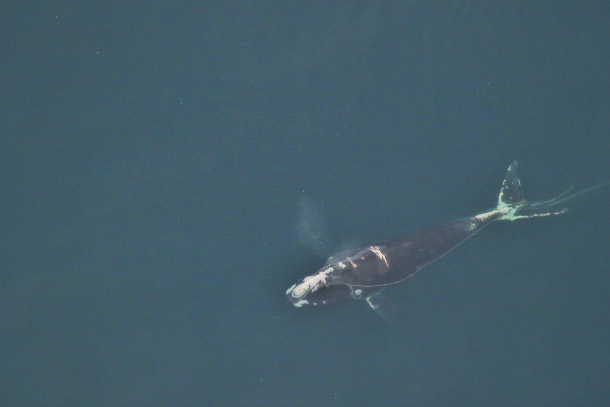
There is hope that "on-demand" fishing gear, which eliminates the need for fixed buoy endlines, will prevent accidental right whale entanglements. (Photo: Clearwater Marine Aquarium Research Institute, Flickr, taken under NOAA permit number 20556. Funded by United States Army Corps of Engineers)
Ship strikes can be deadly for North Atlantic Right Whales, but many of their untimely deaths are from entanglements with fishing gear, usually the long ropes that attach lobster and crab traps at the bottom of the ocean to buoys at the surface. So, there are efforts to design gear that would render the constant presence of those ropes unnecessary, making it much safer for nearby whales. Mark Baumgartner of the Woods Hole Oceanographic Institution joins Host Bobby Bascomb to explain the options and challenges of transitioning to this type of fishing gear.
Transcript
BASCOMB: By the way, NOAA Fisheries has been working on the problem of ship strikes. Last August they proposed regulations to expand the area where ships are required to reduce their speed, including smaller boats. The agency has received over 90 thousand public comments on the proposal and expects to finish the rulemaking and start enforcing stricter speed limits sometime this year.
CURWOOD: But for many, that's not soon enough especially as vulnerable calves are being born right now. So, in November, several NGOs filed petitions asking the agency to speed up the process and implement emergency regulations, like those already proposed, but right now during calving season. NOAA denied the petitions saying they would pull agency resources away from progress on the long-term goal to create an environment for the whales that is safer from ship strikes.
BASCOMB: But, Steve, preventing ship strikes is only one part of protecting right whales. Roughly three quarters of north Atlantic right whale mortalities are from entanglements with fishing gear, specifically the long ropes that attach lobster and crab traps at the bottom of the ocean to buoys at the surface.
CURWOOD: And Bobby, entanglements with ropes are such a concern that the Marine Stewardship Council suspended its sustainability certificate in November for the lobster fishery in the Gulf of Maine. That led Whole Foods to pause its sale of Maine lobsters. The Maine lobster industry says there's no direct evidence linking their gear to dead whales.
BASCOMB: But engineers are working on fishing gear that doesn't involve long vertical ropes through the water that easily ensnare whales. So called, "on demand" fishing gear would release a flotation device connected to the trap only when it is needed, the moment lobstermen are ready to collect their haul. I called up Mark Baumgartner at the Woods Hole Oceanographic Institution to understand the options for designing such on-demand gear.
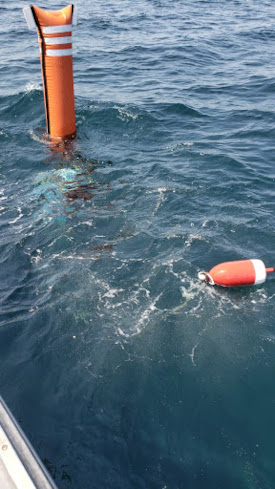
One way to avoid endlines is to use a "lift bag" instead, which is attached to a cage containing compressed air tanks, which is in turn attached to a lobster trawl on the ocean floor. The lift bag inflates when it receives a signal, bringing the trawl to the surface for retrieval. (Photo: NOAA Fisheries)
BAUMGARTNER: There's two ways to do that. One is to have some sort of stowed rope. So take your endline and just stick it in a cage of some sort, just stow it at the seafloor with the float. There's another technique called a lift bag where you just have a deflated bag attached to like a scuba tank. And when you want to get the gear back, you just basically blow up the bag from the scuba tank. So you have an endline on-demand or you have buoyancy on-demand. And the way the fishermen would trigger this is through what we call acoustics. They would have a device that would make particular sounds that a device on the seafloor would interpret as, my fisherman is here, he wants his gear back, I'm going to release either the stowed rope, or I'm going to fill the lift bag with air and the end of the trawl is going to come to the surface. Those are the two ways and we have, we've used those techniques. The stowed rope idea comes directly from the oceanographic community, we've been using that, systems like that, for decades. The lift bags come from the marine salvage community, and have been used for decades. So these are not new approaches. They just have to be scaled appropriately, and affordably, for the fishing industry to make it work for them.
BASCOMB: Well, that's the thing, if these aren't new technologies, what is holding us back from implementing them at a larger scale?
BAUMGARTNER: At this point, it's not really the retrieval mechanisms that's holding back the use of this, it's really marking the location of the gear. That's a technological problem that again, we have solutions for but everyone has to agree on what those solutions are. So for instance, if you're out fishing, and you're using one method of locating your gear, and I'm using another method of locating our gear, such that you can't see where my gear is, and I can't see where your gear is, those systems are completely ineffective for dealing with gear conflict, because I can lay my gear over yours, and you can lay your gear over mine because you can't see them. So there has to be some agreement about what the system will look like. And a lot of the last five years has been sort of prototyping different ideas for how this technology might work. And we're at the point where we have to pick which technology, which methodology we're going to use to locate the gear, and then we have to develop systems that will be compliant with those. And that's a people problem. That's not a technology problem. That's getting manufacturers and government and fishermen and scientists together to agree on open standards about how these systems would work.
BASCOMB: So let's assume that everybody can agree what those standards would look like and agree on a technology to implement, how expensive is it going to be? And who's going to pay?
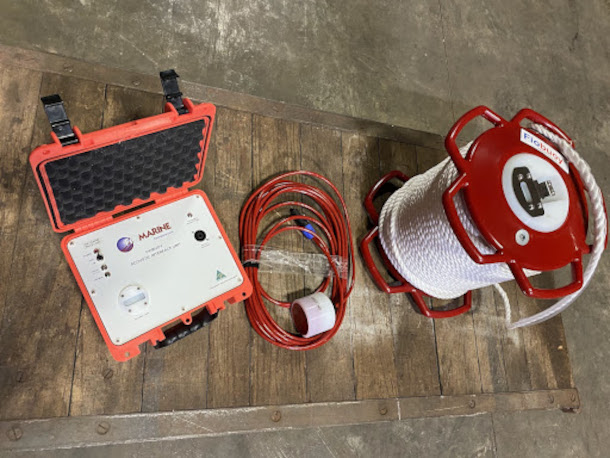
Endlines can also be wrapped around a buoyant spool, which is stored on the ocean floor until it receives a release signal. The endline can then unwind as the spool floats to the surface. (Photo: NOAA Fisheries)
BAUMGARTNER: That's a difficult question to answer at this point, Bobby, because a lot of the gear that's out there, in use, being trialed today, is really prototypes. They're not designed for mass manufacturing. The system today is not designed to promote competition among manufacturers to help drive costs down. So I can't tell you what the cost is. And believe me that's extraordinarily frustrating for many of us, particularly, and most importantly, the fishermen. The fishermen rightly see on-demand fishing as a real economic threat to them. If they have to replace every rope with some complex technological system, that we can't tell them what it costs, there's going to be a lot of anxiety. And there is a lot of anxiety about this on-demand fishing concept. Many fishermen are worried it's going to put them out of business. And so, my hope is that you could be doing this for a couple of hundred dollars per trawl. It's still a big investment. And that's where I think, if we think protecting right whales and other marine species is important, and we've enshrined that in things like the Endangered Species Act and the Marine Mammal Protection Act, we have a responsibility as a society to help fishermen through this. This is not their fault. Entanglements happen as industrial accidents. There's no fisherman out there that wants to hurt a right whale or any other species. And so the solution to that then is subsidizing the cost of the purchase of the gear.
BASCOMB: Right. It seems like if we are serious about avoiding the extinction of you know, this species of whale, that maybe this is a place where the government should step in and say, okay, we're going to require these new technologies, but we'll help you pay for them.
BAUMGARTNER: Absolutely, Bobby. The government has a huge role to play here. Currently, it's illegal to use on-demand fishing. The regulations say that you have to use a buoy, in which case you have to use an endline. So fishermen are required to use gear that is not sustainable for right whales and other species. So the government has to change the regulations. They have to support the open standards because they have to tell the manufacturers what gear is going to be compliant to reduce this gear conflict problem. And ultimately, I agree with you they have to be the ones who provide the funding to help the fishermen basically end these industrial accidents that are threatening the very existence of North Atlantic right whales.
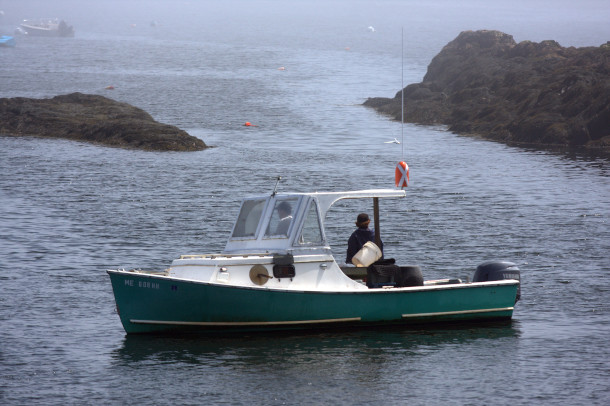
Many lobstermen argue that without a standardized network that allows all fishermen to see the location of the traps, on-demand fishing will lead to “gear conflict.” Gear conflict occurs when a fisherman lays his traps on top of another fisherman’s traps. (Photo: Rob Kleine, Flickr, CC BY-NC 2.0)
BASCOMB: And are there any other advantages to the fishermen themselves for having this type of technology? I mean, you know, there's the stick of, we have these new rules, and you have to implement them if you want to participate. But is there any carrot to be had here? Is there anything in it for them to adopt these new technologies?
BAUMGARTNER: I think so. One of the things we're hoping with this technology is that the gear location marking piece will help fishermen keep track of their gear a lot better. Today, fishermen lose gear at sea. Another type of gear conflict happens with mobile fisheries, a fisherman dragging a net say to collect scallops, or something living on the seafloor, will sometimes just plow through a lobstermen's gear and carry that gear miles and miles away, where the fisherman will never see it. There are some estimates that suggest that fishermen lose up to 10 percent of their gear per year. The gear location marking technologies that will likely be used, basically, imagine if your gear gets dragged away, miles away, you get a text that says, hey, your trawl number 775 has moved, here's its new location. Now you have a chance to go recover that gear. And so it has the potential to save fishermen a lot of money. They don't have to buy 10 percent of their gear every single year. And it deals with what we call the ghost gear, this trash gear problem, which is a big environmental issue as well.
BASCOMB: It does seem that another hurdle here is getting all of the stakeholders involved and on the same page. What progress are you seeing towards that right now?
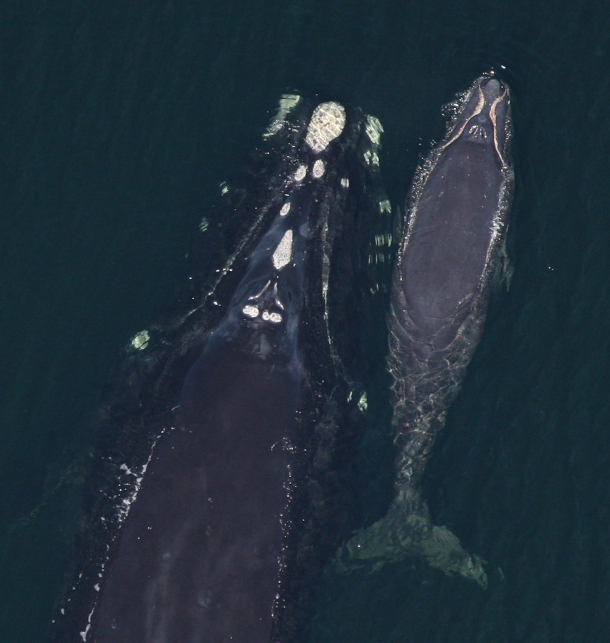
About 75 percent of documented right whale mortalities are a result of entanglements, while 25 percent are caused by ship strikes. (Photo: Florida Fish and Wildlife Conservation Commission, Flickr, NOAA Research Permit number 594-1759)
BAUMGARTNER: Lobster fishing is as iconic, perhaps more iconic than even right whales in New England. If you've ever been out at sea in New England, you've seen lobster buoys everywhere. And they're a huge part of the coastal economy. So preserving the fishery and preserving sort of the culture of fishing is quite important. So you'll meet two kinds of fishermen in this on-demand debate. One, right whales just don't come very often to their area and their area's not really up for closures. Right now, the only tool the government has to deal with the entanglement issue is to issue closures. Closures are devastating for, for the fishing community. And so if you're not facing a closure, you're likely going to be extremely resistant to the idea of on-demand fishing. But we have a lot of fishermen in both Massachusetts and now Maine, as well as in Canada, that are faced with closures because right whales come to their waters often. Those fishermen are, by and large, more open to experimenting with on demand fishing and seeing if it's going to work. They're certainly not happy about it because of the economic costs. And the concern that it's not going to have a good solution for gear conflict issues. But they're very willing to give it a try because they want to keep fishing. There's a generation of fishermen that want to be in the industry for the next 10, 20, 30 years and are looking out and saying, if these closures keep going, I'm not going to be able to fish. I just spoke a couple months ago with a fisherman who's probably in his 60s. And he's been trying this ropeless fishing out, and he said, you know, Mark, the reason I'm doing this is because my son is in the industry. And I want to make sure that he can continue to fish. So, there's that culture, that sort of generational thing of handing down the fishing knowledge from father to son, mother to daughter, and I think on-demand fishing can fit right in there.
BASCOMB: Mark Baumgartner is a senior scientist at the Woods Hole Oceanographic Institution. Mark, thank you so much for your time today.
BAUMGARTNER: It was my pleasure, Bobby.
Links
Ropeless Consortium | "Towards Whales Without Rope Entanglements"
NOAA Fisheries | "Developing Viable On-Demand Gear Systems"
NOAA Fisheries | "North Atlantic Right Whale"
Living on Earth | "Lobster Industry on the Hook to Save Right Whales"
Living on Earth wants to hear from you!
Living on Earth
62 Calef Highway, Suite 212
Lee, NH 03861
Telephone: 617-287-4121
E-mail: comments@loe.org
Newsletter [Click here]
Donate to Living on Earth!
Living on Earth is an independent media program and relies entirely on contributions from listeners and institutions supporting public service. Please donate now to preserve an independent environmental voice.
NewsletterLiving on Earth offers a weekly delivery of the show's rundown to your mailbox. Sign up for our newsletter today!
 Sailors For The Sea: Be the change you want to sea.
Sailors For The Sea: Be the change you want to sea.
 The Grantham Foundation for the Protection of the Environment: Committed to protecting and improving the health of the global environment.
The Grantham Foundation for the Protection of the Environment: Committed to protecting and improving the health of the global environment.
 Contribute to Living on Earth and receive, as our gift to you, an archival print of one of Mark Seth Lender's extraordinary wildlife photographs. Follow the link to see Mark's current collection of photographs.
Contribute to Living on Earth and receive, as our gift to you, an archival print of one of Mark Seth Lender's extraordinary wildlife photographs. Follow the link to see Mark's current collection of photographs.
 Buy a signed copy of Mark Seth Lender's book Smeagull the Seagull & support Living on Earth
Buy a signed copy of Mark Seth Lender's book Smeagull the Seagull & support Living on Earth

